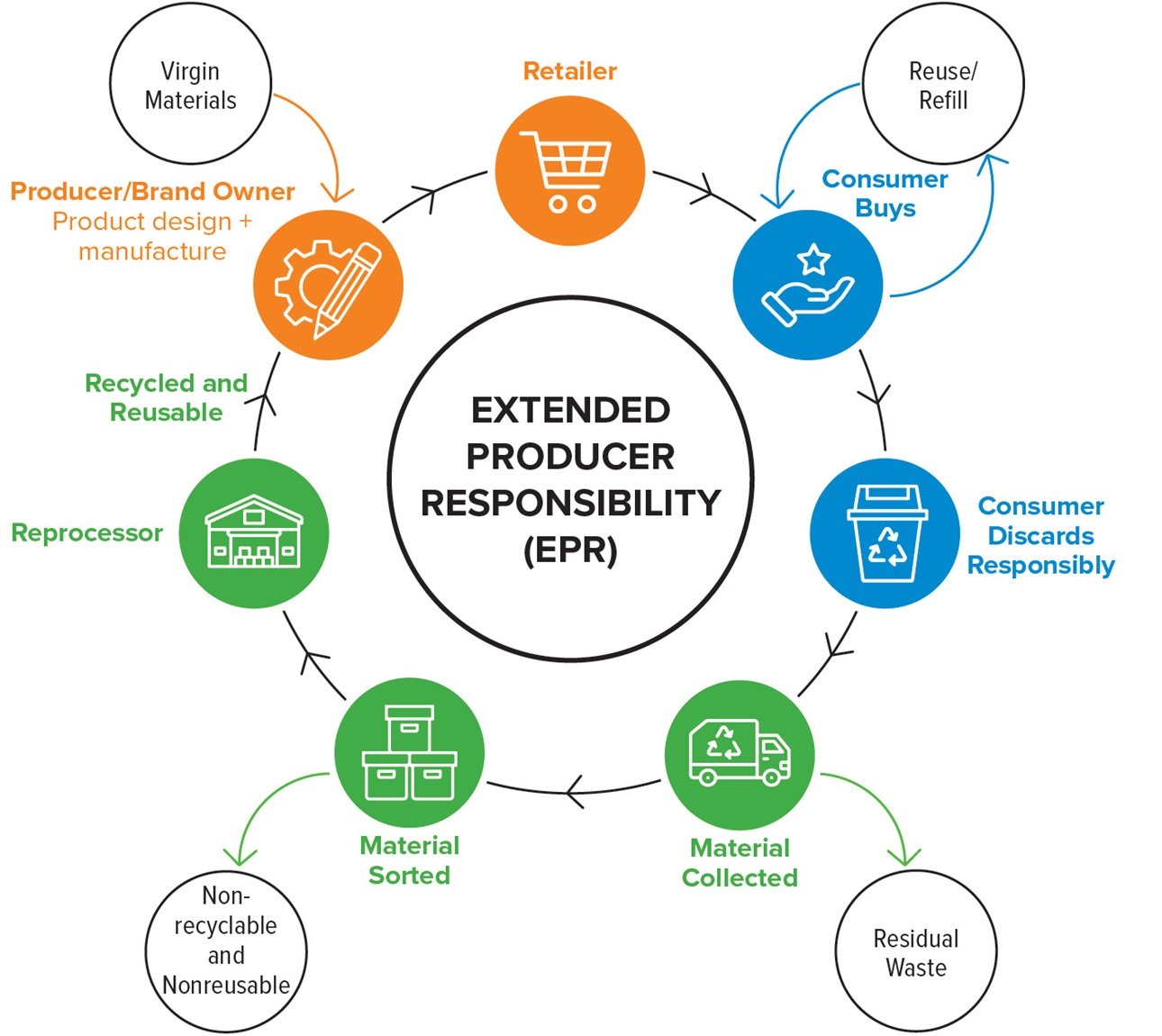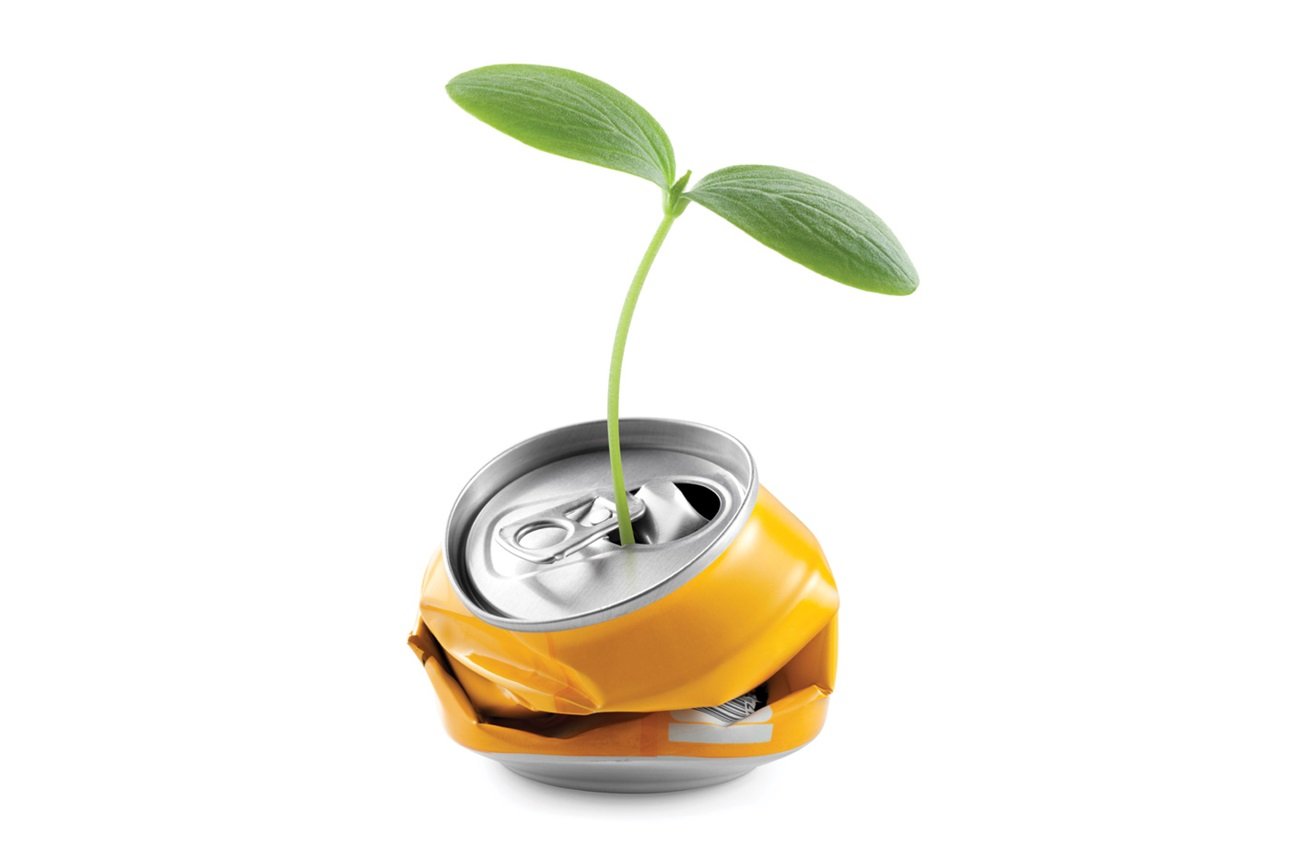Food Technology Magazine | Applied Science
How to Achieve EPR-Forward Packaging
In this two-part series, the author explores the history of Extended Producer Responsibility (EPR), what is needed to help EPR succeed, and how brands can best prepare for EPR.

© Thawatchai Chawong/iStock/Getty Images Plus
Extended Producer Responsibility (EPR) is coming to the United States. Packaging EPR was proposed in 14 states in 2023 and enacted within California, Colorado, Maine, and Oregon. EPR is an environmental policy approach that uses eco-modulation to determine the cost for the entire packaging life cycle. Resulting tariffs are assigned by package material weight and cost of disposal, with recycling having the lowest tariff. The core benefit of EPR is lowering the environmental impact of packaging by optimizing packaging and funding the collection and sorting of packaging for more responsible disposal. More than 150 companies and organizations have publicly committed to support EPR for collecting and recycling packaging at scale.
Packaging EPR in Perspective
Packaging EPR exists in 41 countries, including Argentina, Australia, Brazil, Chile, China, Colombia, Dominican Republic, the European Union (EU), India, Mexico, Japan, New Zealand, Pakistan, United Kingdom, and Russia. For many countries, such as Colombia, EPR for packaging was already part of systems for other materials such as batteries, light bulbs, computers and peripherals, pesticides, tires, and used oils.
In 1992, the German DerGrünePunkt system became the first to use EPR for large-scale packaging. Thomas Gröner, director of TG Pack Solutions in Germany, notes, “EPR was and is still complementary to bottle return deposits similar to those in 10 states in the United States, and it applied an economic value to collect, sort, and recycle all packaging.” For example, he says, composites made of paper, metal, and plastic that were difficult to recycle had a higher tariff. In contrast, thin flexible packaging made of a single recyclable material had a lower tariff. This resulted in a minimalistic redesign of materials and recyclable packaging, and collection and sorting systems became more efficient.
Most importantly, all packaging materials can be separated and recycled. However, the benefit of recycling does not always outweigh the environmental impact and/or cost of separation. Composite recycling initiatives have a high cost and environmental impact and are only financially viable if the energy from difficult-to-separate structures is captured through incineration.
The EU Packaging and Packaging Waste Regulation (PPWR) and eco-modulation are critical for providing brand guidance, Gröner says. “Only six of the 31 EU countries currently use the eco-modulation required by the directive,” he notes. “This will mean changes in packaging and fuel, improved packaging collection and sorting systems.”
Critically, some regions and countries have high recycling rates in the absence of EPR systems. This highlights the role of culture in achieving high recycling rates. “Lowering the environmental impact of packaging requires high collection rates, sorting rates, and recycling rates,” Gröner adds. “If we fail at the first step, collection, we will fail on all three. We need consumers to recycle to make collection easier.”
Making EPR a Success in the United States
The environmental and social aspects warrant consideration. The economic impact of recycling in the United States is estimated at $70.3 billion, with the actual material value of recycled materials representing only 11% of the impact. Other impacts are larger, with 31% environmental value associated with reducing greenhouse gas emissions and 58% social value associated with wages and economic development (euomia 2023).
More than 115 EPR policies across 33 states in the United States cover 14 categories, including mattresses, electronics, mercury thermostats, and batteries. EPR tariffs for package collection will be funded only in states that have adopted EPR. However, the package design and materials selected by national brands based on EPR will be used nationwide. “Packaging-specific EPR has been inevitable in the USA for almost 35 years,” notes Calvin Lakhan, research scientist and co-investigator of the “Waste Wiki” project at Canada’s York University. “Since consumers use and dispose of packaging more frequently than longer-use items with EPR, such as electronics, packaging EPR will have a more intimate social impact on consumers.”
As a result, focusing on both environmental and social aspects is critical for developing a successful EPR program. However, the social aspect of EPR is often overlooked, Lakhan explains. “On the social front, we must ensure that the EPR investment is worthwhile. However, this isn’t always the case, and financial accountability is necessary.” For example, Recycle BC’s EPR program for printed paper and packaging has been touted as a resounding success. The program, based in British Columbia, Canada, boasts recovery rates for plastics more than 97%, and more than 99.2% of the population has access to recycling services.
However, Lakhan says that the numbers may not be what they appear. “Since 2015, the recovery rate per capita in British Columbia has decreased by 7%, while the cost of recycling per household has increased by 53%. Essentially, we are paying more to recycle less. Activity-based costing is critical for ensuring that EPR investments yield results.” EPR fees are frequently passed on to consumers, he says, and thus are a regressive tax. Even though EPR tariffs for packaging are low—for example, two-tenths of a penny for a polyethylene terephthalate (PET) bottle and one-tenth for an aluminum can—the fees generated must be used to maximize benefit (Lakhan 2021).
Julia Willsie, senior sales executive, Mill Rock Packaging Partners, adds, “The amount and type of packaging that the collection and sorting system must handle vary dramatically by region. Recycling centers adjust to local populations and resources and must be profitable while meeting local regulations.”
As a best practice, needs assessments ensure that the social aspects of EPR are addressed. For example, before developing EPR legislation, Oregon conducted a needs assessment to ensure that EPR could effectively address the collection and sorting dynamics unique to Oregon’s urban and rural regions. Chaz Miller, CEO of Miller Recycling Associates, says the needs assessment showed a lack of processing capacity throughout rural Oregon. “As a result, the law stressed the need to consolidate and transfer recyclables to larger MRFs [materials recovery facilities] in the state’s more populated areas.”
Miller adds that because there is no national authority in the United States to implement EPR, “[it] will be implemented at the state level, with needs assessments possible to ensure that EPR aligns with different needs in different states.” For example, Maryland SB 222, which took effect in May 2023, requires statewide needs assessment to be presented to an advisory council, which will then submit recommendations by December 2024 for developing a scheme law by 2025. Conducting a needs assessment will also allow for harmonizing EPR legislation with implementation specifics aligned with state needs.
As Gröner noted about the EU, encouraging recycling is critical for EPR in the United States to succeed. Creating incentives and nudges for people to recycle must include all households and economic and social groups. There is room for improvement. For example, recycling rates for paperboard and corrugate are 38%–55%, even though 94% of households have access to curbside recycling. Tennessee ranks 48th in the United States for recycling, with only 5% of all packaging being recycled. Gary Cohen, a Reimagine Packaging Coalition committee member, explains how work is underway to increase recycling. “Our Tennessee coalition is working hard to pass EPR bill SB0573/HB0550 by focusing on the social aspects of job and industry creation, cleaner air, rivers, roads, forests, parks, and stormwater systems, due to less litter,” he says.
A First Step in Preparing for EPR
As EPR gains traction in the United States, packaging EPR programs implemented in more than 40 countries can be used as guides to improve recycling processes and labeling. However, scaling up recycling is a challenge. Although insights into process and labeling can be gained, there is no global or U.S.-centric EPR harmonization forecasted. Fee structures for brands with a global and national presence differ depending on the material and packaging format. Despite this inconsistency, brands should pursue EPR-forward packaging to ensure lower fees and compliance with the legislation. EPR-forward packaging can be implemented by brands while ensuring that lowering the food system’s environmental impact remains center-stage. This requires a multipronged approach focusing on lowering the environmental impact of our entire food system while pursuing wise package material reductions, investing in recyclable packaging, and assessing reusable packaging.
The first step is to focus on lowering the environmental impact of the food system. With EPR still on the horizon, brands have time to explore the role of primary, secondary, and tertiary packaging and how they can lower EPR fees by cost-effectively balancing operational and value chain changes. However, focusing on reducing the food system’s environmental impact is paramount, even under EPR. To ensure a more sustainable food system, there are three aspects to consider: food waste, food preservation, and the use of recycled content.
Food waste. By reducing food waste associated with packaged food, EPR fees can be significantly lowered because less packaged food will need to be disposed of throughout the system. For example, if fresh packaged spinach wastage was reduced from the current 59%, fewer packages would need to be paid for using the EPR scheme. Technologies such as modified atmosphere packaging may increase per-package EPR fees but result in lower overall EPR fees and overall environmental impact because less packaging overall would be consumed. This is especially true in areas with high food waste, such as produce. Further, more sustainable packaging has a role, but perspective is essential: Packaging generates about 80% less greenhouse gas than food waste (Poore and Nemecek 2018).
Food preservation. A change in preservation methods can lower EPR fees but alter the environmental impact of packaged food. Freezing food for preservation has a high environmental impact, and frozen foods often require fewer packaging barrier properties. So, a package reduction can occur in the conversion from shelf-stable to frozen food even though the environmental impact of the food from farm to fork will increase. Alternatively, if food packaging is restricted to the point that lower-impact processing and product solutions are not viable, an increase in environmental impact may occur.
Use of recycled content. EPR legislation does not address the use of recycled content, even though it provides a use for the mandated levels of recycling. Importantly, the U.S. Food and Drug Administration (FDA) governs use of recycled content in direct food contact by condition of use and food types. Recycled plastics approved for direct contact with food are easily determined through the FDA database (FDA 2024). A chain of custody is critical for recycled content in direct food contact. Notably, direct contact with recycled content with some plastic is only allowed for specific food types if the plastic has had prior use only in contact with food. The chain of custody of recycled paper from food or office paper sources allows 12% recycled content paperboard to be in direct contact with Starbucks coffee, for example. However, more recycled fibers are needed to match the same strength as virgin fibers, which translates into higher weight-based EPR fees. Regardless, if recycled content is safe and lowers the environmental impact of packaging, it should be part of a brand sustainability strategy.
Next Steps
Constructing a plan for EPR-forward packaging that reduces the environmental impact on the food system goes beyond the first step of focusing on lowering the environmental impact of the food system. In Part 2 of this series, we’ll outline several other steps that brands can take to prepare for EPR, including packaging amount reduction, investment in recyclability, and assessing the applicability of reusable packaging.ft







